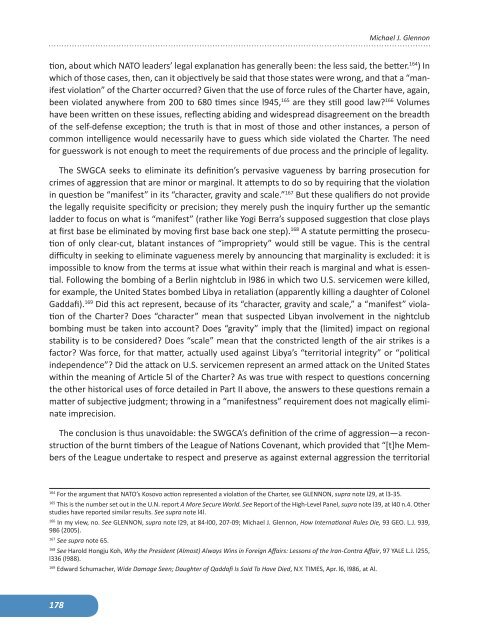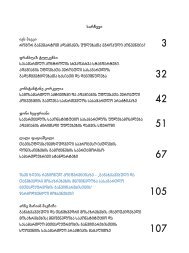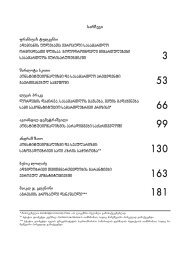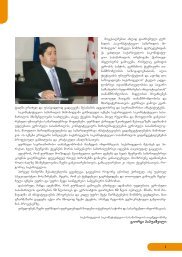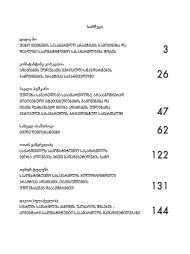Contents - Constitutional Court of Georgia
Contents - Constitutional Court of Georgia
Contents - Constitutional Court of Georgia
You also want an ePaper? Increase the reach of your titles
YUMPU automatically turns print PDFs into web optimized ePapers that Google loves.
178<br />
Michael J. Glennon<br />
tion, about which NATO leaders’ legal explanation has generally been: the less said, the better. 164 ) In<br />
which <strong>of</strong> those cases, then, can it objectively be said that those states were wrong, and that a “manifest<br />
violation” <strong>of</strong> the Charter occurred? Given that the use <strong>of</strong> force rules <strong>of</strong> the Charter have, again,<br />
been violated anywhere from 200 to 680 times since l945, 165 are they still good law? 166 Volumes<br />
have been written on these issues, reflecting abiding and widespread disagreement on the breadth<br />
<strong>of</strong> the self-defense exception; the truth is that in most <strong>of</strong> those and other instances, a person <strong>of</strong><br />
common intelligence would necessarily have to guess which side violated the Charter. The need<br />
for guesswork is not enough to meet the requirements <strong>of</strong> due process and the principle <strong>of</strong> legality.<br />
The SWGCA seeks to eliminate its definition’s pervasive vagueness by barring prosecution for<br />
crimes <strong>of</strong> aggression that are minor or marginal. It attempts to do so by requiring that the violation<br />
in question be “manifest” in its “character, gravity and scale.” 167 But these qualifiers do not provide<br />
the legally requisite specificity or precision; they merely push the inquiry further up the semantic<br />
ladder to focus on what is “manifest” (rather like Yogi Berra’s supposed suggestion that close plays<br />
at first base be eliminated by moving first base back one step). 168 A statute permitting the prosecution<br />
<strong>of</strong> only clear-cut, blatant instances <strong>of</strong> “impropriety” would still be vague. This is the central<br />
difficulty in seeking to eliminate vagueness merely by announcing that marginality is excluded: it is<br />
impossible to know from the terms at issue what within their reach is marginal and what is essential.<br />
Following the bombing <strong>of</strong> a Berlin nightclub in l986 in which two U.S. servicemen were killed,<br />
for example, the United States bombed Libya in retaliation (apparently killing a daughter <strong>of</strong> Colonel<br />
Gaddafi). 169 Did this act represent, because <strong>of</strong> its “character, gravity and scale,” a “manifest” violation<br />
<strong>of</strong> the Charter? Does “character” mean that suspected Libyan involvement in the nightclub<br />
bombing must be taken into account? Does “gravity” imply that the (limited) impact on regional<br />
stability is to be considered? Does “scale” mean that the constricted length <strong>of</strong> the air strikes is a<br />
factor? Was force, for that matter, actually used against Libya’s “territorial integrity” or “political<br />
independence”? Did the attack on U.S. servicemen represent an armed attack on the United States<br />
within the meaning <strong>of</strong> Article 5l <strong>of</strong> the Charter? As was true with respect to questions concerning<br />
the other historical uses <strong>of</strong> force detailed in Part II above, the answers to these questions remain a<br />
matter <strong>of</strong> subjective judgment; throwing in a “manifestness” requirement does not magically eliminate<br />
imprecision.<br />
The conclusion is thus unavoidable: the SWGCA’s definition <strong>of</strong> the crime <strong>of</strong> aggression—a reconstruction<br />
<strong>of</strong> the burnt timbers <strong>of</strong> the League <strong>of</strong> Nations Covenant, which provided that “[t]he Members<br />
<strong>of</strong> the League undertake to respect and preserve as against external aggression the territorial<br />
164 For the argument that NATO’s Kosovo action represented a violation <strong>of</strong> the Charter, see GLENNON, supra note l29, at l3-35.<br />
165 This is the number set out in the U.N. report A More Secure World. See Report <strong>of</strong> the High-Level Panel, supra note l39, at l40 n.4. Other<br />
studies have reported similar results. See supra note l4l.<br />
166 In my view, no. See GLENNON, supra note l29, at 84-l00, 207-09; Michael J. Glennon, How International Rules Die, 93 GEO. L.J. 939,<br />
986 (2005).<br />
167 See supra note 65.<br />
168 See Harold Hongju Koh, Why the President (Almost) Always Wins in Foreign Affairs: Lessons <strong>of</strong> the Iran-Contra Affair, 97 YALE L.J. l255,<br />
l336 (l988).<br />
169 Edward Schumacher, Wide Damage Seen; Daughter <strong>of</strong> Qaddafi Is Said To Have Died, N.Y. TIMES, Apr. l6, l986, at Al.


